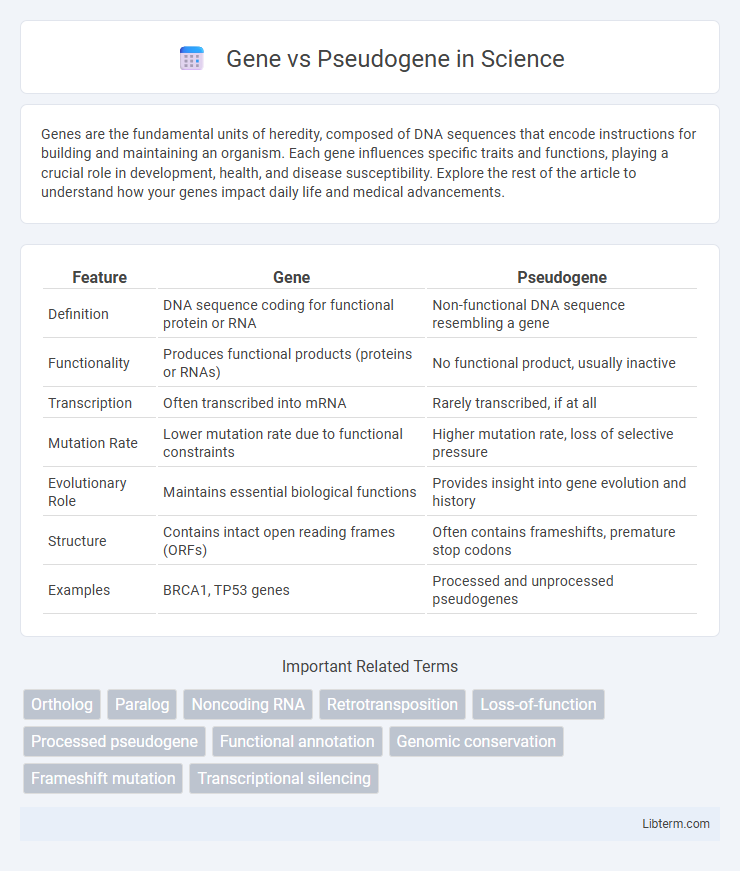Genes are the fundamental units of heredity, composed of DNA sequences that encode instructions for building and maintaining an organism. Each gene influences specific traits and functions, playing a crucial role in development, health, and disease susceptibility. Explore the rest of the article to understand how your genes impact daily life and medical advancements.
Table of Comparison
| Feature | Gene | Pseudogene |
|---|---|---|
| Definition | DNA sequence coding for functional protein or RNA | Non-functional DNA sequence resembling a gene |
| Functionality | Produces functional products (proteins or RNAs) | No functional product, usually inactive |
| Transcription | Often transcribed into mRNA | Rarely transcribed, if at all |
| Mutation Rate | Lower mutation rate due to functional constraints | Higher mutation rate, loss of selective pressure |
| Evolutionary Role | Maintains essential biological functions | Provides insight into gene evolution and history |
| Structure | Contains intact open reading frames (ORFs) | Often contains frameshifts, premature stop codons |
| Examples | BRCA1, TP53 genes | Processed and unprocessed pseudogenes |
Understanding Genes: Definition and Function
Genes are segments of DNA that encode instructions for synthesizing proteins essential to biological functions and organism development. Pseudogenes resemble functional genes but contain mutations that prevent them from producing functional proteins, serving as evolutionary remnants. Understanding the distinction between active genes and pseudogenes aids in studying genetic regulation, disease mechanisms, and genome evolution.
What Are Pseudogenes? Types and Characteristics
Pseudogenes are genomic DNA sequences resembling functional genes but lack protein-coding ability due to accumulated mutations such as frameshifts or premature stop codons. They are classified mainly into three types: processed pseudogenes, which arise from retrotransposition events and lack introns; non-processed pseudogenes, originating from gene duplication but no longer functional; and unitary pseudogenes, which have lost function without duplication. Characterized by sequence similarity to parent genes yet disrupted transcription or translation, pseudogenes provide insight into genomic evolution and gene regulation.
Key Differences Between Genes and Pseudogenes
Genes encode functional proteins or RNA molecules essential for cellular processes, while pseudogenes are non-functional DNA segments resembling genes but containing mutations that prevent their expression. Unlike genes, pseudogenes often arise from gene duplication or retrotransposition events and lack regulatory elements needed for proper transcription. The primary distinction lies in functionality; genes are actively transcribed and translated, whereas pseudogenes typically do not produce functional products.
Evolutionary Origins of Pseudogenes
Pseudogenes arise from the duplication or mutation of functional genes, serving as genomic fossils that trace evolutionary events. These sequences result from gene duplication, retrotransposition, or gene deterioration, often accumulating mutations that disable their original protein-coding function. The presence of pseudogenes provides insight into gene evolution, revealing patterns of genetic drift, selective pressures, and genomic rearrangements in various species.
Functional Roles of Pseudogenes: More Than Junk DNA
Pseudogenes, once considered non-functional genomic relics, play critical roles in regulating gene expression, acting as decoys for microRNAs and influencing mRNA stability. These genomic elements participate in gene regulatory networks, impacting cellular processes such as development and disease progression, including cancer. Emerging research highlights pseudogenes as important contributors to genetic innovation and evolutionary adaptation, challenging their label as mere "junk DNA.
Methods for Identifying Genes and Pseudogenes
Gene identification methods typically involve homology-based annotation using sequence alignment tools such as BLAST and ab initio prediction models like GENSCAN, which analyze coding potential and conserved motifs. Pseudogene identification relies on detecting characteristic features including premature stop codons, frameshift mutations, and lack of transcriptional evidence, often using pipelines such as PseudoPipe or Retrofinder that differentiate non-functional homologs from functional genes. Recent advances incorporate RNA sequencing data and comparative genomics to improve accuracy in distinguishing expressed genes from non-expressed pseudogenes.
Impact of Pseudogenes on Gene Regulation
Pseudogenes influence gene regulation by acting as competitive endogenous RNAs (ceRNAs) that sequester microRNAs, thereby modulating the expression of their functional gene counterparts. These non-coding sequences can generate regulatory RNAs or peptides affecting transcriptional and post-transcriptional processes. Understanding pseudogene-mediated gene regulation provides insights into genetic disorders and cancer development linked to aberrant gene expression patterns.
Pseudogenes in Genetic Diseases
Pseudogenes, once considered nonfunctional genomic relics, play significant roles in genetic diseases by regulating gene expression and influencing pathological pathways. Certain pseudogenes contribute to oncogenesis, neurodegenerative disorders, and inherited genetic syndromes through mechanisms like gene conversion, antisense RNA production, and competitive endogenous RNA activity. Understanding pseudogene involvement aids in uncovering novel biomarkers and therapeutic targets for complex genetic diseases.
Pseudogenes and Genome Evolution
Pseudogenes are non-functional segments of DNA that resemble functional genes but have lost their protein-coding ability due to mutations, serving as genomic fossils that trace evolutionary history. These sequences contribute to genome evolution by providing raw material for genetic innovation through mechanisms such as gene duplication, sequence divergence, and potential regulatory roles in gene expression. Studying pseudogenes enhances understanding of genome dynamics, evolutionary pressures, and the complexities of genetic regulation in various organisms.
Future Directions in Gene and Pseudogene Research
Future directions in gene and pseudogene research emphasize advanced genomic technologies such as single-cell RNA sequencing and CRISPR-based gene editing to unravel functional roles and regulatory mechanisms. Increasing evidence highlights pseudogenes as potential sources of regulatory RNAs and gene expression modulators, prompting deeper exploration into their involvement in disease pathways and therapeutic targets. Integration of multi-omics data and machine learning approaches is poised to accelerate discovery of pseudogene functions and their impact on genomic stability and evolution.
Gene Infographic

 libterm.com
libterm.com